An Analysis of IKEA's Marketing Strategies and Digital Marketing
VerifiedAdded on 2020/10/04
|19
|4197
|207
Report
AI Summary
This report provides a comprehensive analysis of IKEA's marketing strategies and digital marketing initiatives. It begins with an introduction to marketing strategy and digital marketing, followed by an analysis of IKEA's marketing plan, including gap analysis and marketing objectives. The report delves into IKEA's marketing mix, segmentation, targeting, and positioning strategies, as well as their marketing tactics. It also examines the implementation of these tactics and provides an analysis of their effectiveness. The report further explores IKEA's digital marketing process, applying the 5S digital marketing strategy and offering recommendations for website and digital marketing improvements. The analysis covers revenue, customer base, and sales data to evaluate the impact of marketing tactics. Recommendations are provided to enhance product quality, digital marketing, and mobile application performance. The report concludes with an overview of the key findings and suggestions for future marketing efforts.
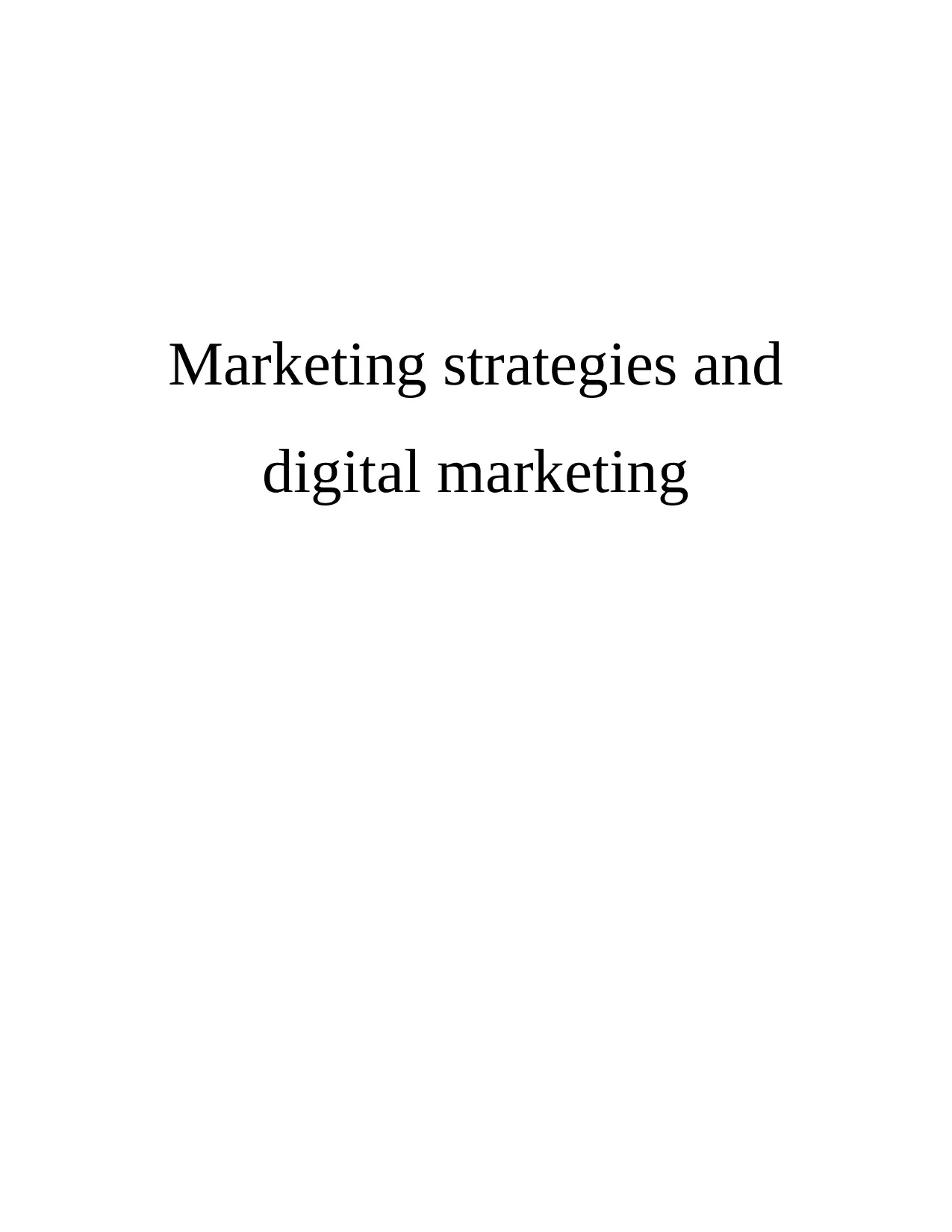
Marketing strategies and
digital marketing
digital marketing
Paraphrase This Document
Need a fresh take? Get an instant paraphrase of this document with our AI Paraphraser
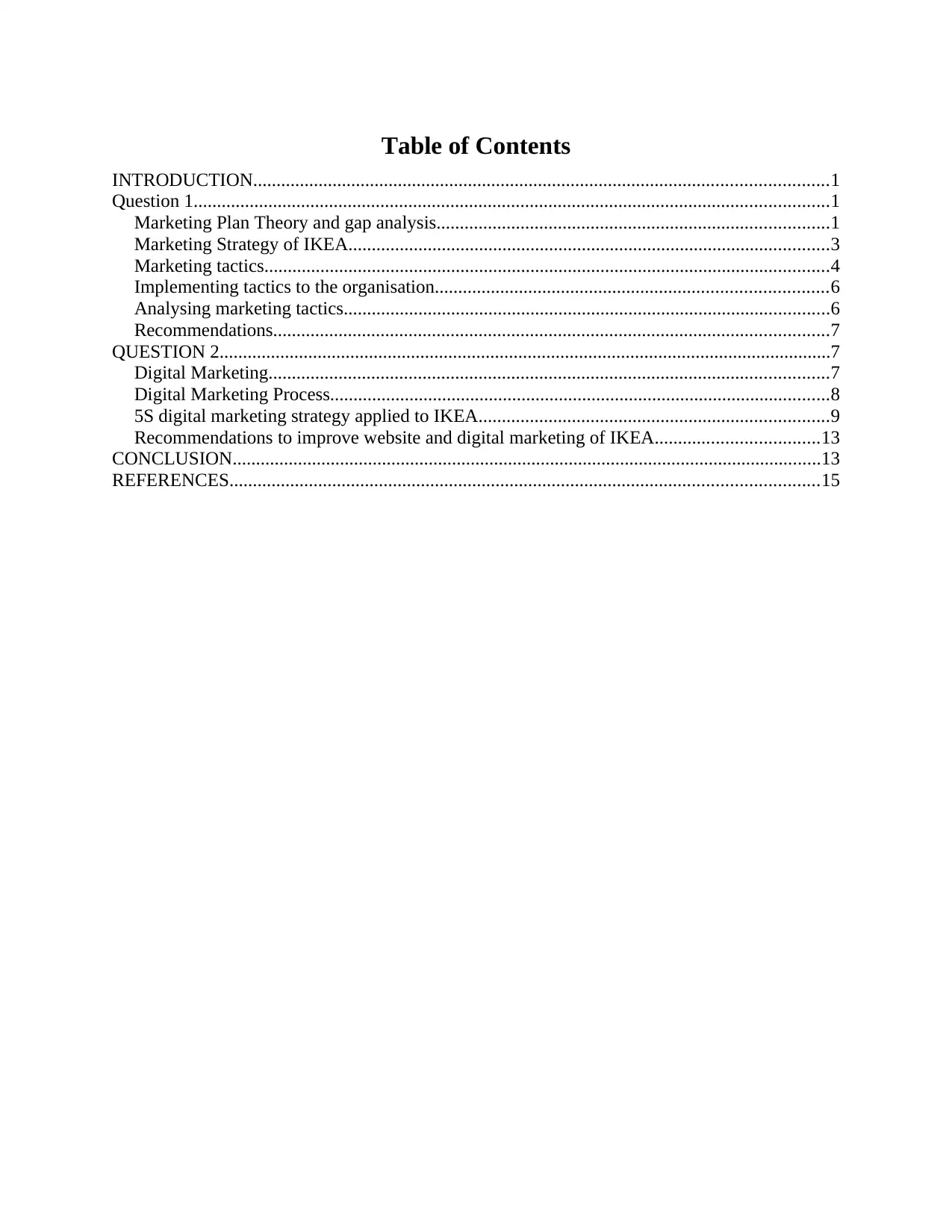
Table of Contents
INTRODUCTION...........................................................................................................................1
Question 1........................................................................................................................................1
Marketing Plan Theory and gap analysis....................................................................................1
Marketing Strategy of IKEA.......................................................................................................3
Marketing tactics.........................................................................................................................4
Implementing tactics to the organisation....................................................................................6
Analysing marketing tactics........................................................................................................6
Recommendations.......................................................................................................................7
QUESTION 2...................................................................................................................................7
Digital Marketing........................................................................................................................7
Digital Marketing Process...........................................................................................................8
5S digital marketing strategy applied to IKEA...........................................................................9
Recommendations to improve website and digital marketing of IKEA...................................13
CONCLUSION..............................................................................................................................13
REFERENCES..............................................................................................................................15
INTRODUCTION...........................................................................................................................1
Question 1........................................................................................................................................1
Marketing Plan Theory and gap analysis....................................................................................1
Marketing Strategy of IKEA.......................................................................................................3
Marketing tactics.........................................................................................................................4
Implementing tactics to the organisation....................................................................................6
Analysing marketing tactics........................................................................................................6
Recommendations.......................................................................................................................7
QUESTION 2...................................................................................................................................7
Digital Marketing........................................................................................................................7
Digital Marketing Process...........................................................................................................8
5S digital marketing strategy applied to IKEA...........................................................................9
Recommendations to improve website and digital marketing of IKEA...................................13
CONCLUSION..............................................................................................................................13
REFERENCES..............................................................................................................................15

Illustration Index
Illustration 1: Brand Logo ...............................................................................................................1
Illustration 2: Gap analysis .............................................................................................................2
Illustration 3: Positioning ................................................................................................................5
Illustration 4: Digital Marketing Process.........................................................................................8
Illustration 5: The 5 S Model of E-Marketing Objectives (Source: MG337, 2015)........................9
Illustration 1: Brand Logo ...............................................................................................................1
Illustration 2: Gap analysis .............................................................................................................2
Illustration 3: Positioning ................................................................................................................5
Illustration 4: Digital Marketing Process.........................................................................................8
Illustration 5: The 5 S Model of E-Marketing Objectives (Source: MG337, 2015)........................9
⊘ This is a preview!⊘
Do you want full access?
Subscribe today to unlock all pages.

Trusted by 1+ million students worldwide

INTRODUCTION
Marketing strategy combines of all the marketing tactics which are utilised by the
marketing management of the organisation so that desired goals and targets can be accomplished.
Digital marketing is the form of marketing in which management promotes their goods and
services on digital platform (Armstrong, Kotler and Brennan, 2015). In accordance with this
context, the marketing strategy and digital marketing platform of IKEA, multinational furniture
and home accessories company will be analysed in this report. The marketing plan of
organisation with respect of marketing plan theory and gap analysis will be made in this report.
Further, the marketing strategy will be formulated in so that the gap can be filled. Further the
implications of digital marketing in respect with Ikea will be analysed in this assignment.
Question 1
Business description: IKEA is an international home product company that designs and sells
ready to assemble furniture appliances and home accessories.
Vision: The vision of the organisation is to create a better everyday life for the many people.
1
Illustration 1: Brand Logo
(Source: IKEA, 2017)
Marketing strategy combines of all the marketing tactics which are utilised by the
marketing management of the organisation so that desired goals and targets can be accomplished.
Digital marketing is the form of marketing in which management promotes their goods and
services on digital platform (Armstrong, Kotler and Brennan, 2015). In accordance with this
context, the marketing strategy and digital marketing platform of IKEA, multinational furniture
and home accessories company will be analysed in this report. The marketing plan of
organisation with respect of marketing plan theory and gap analysis will be made in this report.
Further, the marketing strategy will be formulated in so that the gap can be filled. Further the
implications of digital marketing in respect with Ikea will be analysed in this assignment.
Question 1
Business description: IKEA is an international home product company that designs and sells
ready to assemble furniture appliances and home accessories.
Vision: The vision of the organisation is to create a better everyday life for the many people.
1
Illustration 1: Brand Logo
(Source: IKEA, 2017)
Paraphrase This Document
Need a fresh take? Get an instant paraphrase of this document with our AI Paraphraser
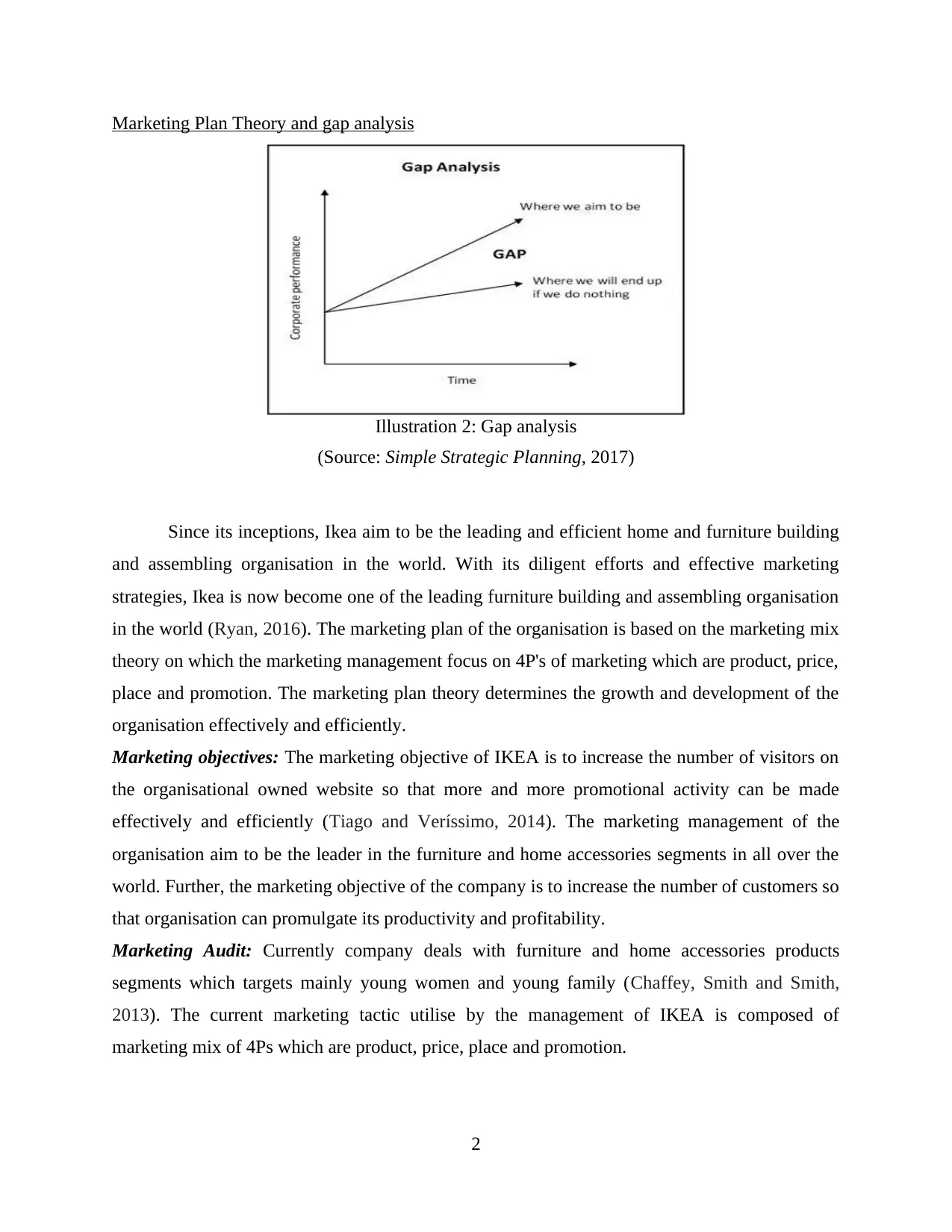
Marketing Plan Theory and gap analysis
Since its inceptions, Ikea aim to be the leading and efficient home and furniture building
and assembling organisation in the world. With its diligent efforts and effective marketing
strategies, Ikea is now become one of the leading furniture building and assembling organisation
in the world (Ryan, 2016). The marketing plan of the organisation is based on the marketing mix
theory on which the marketing management focus on 4P's of marketing which are product, price,
place and promotion. The marketing plan theory determines the growth and development of the
organisation effectively and efficiently.
Marketing objectives: The marketing objective of IKEA is to increase the number of visitors on
the organisational owned website so that more and more promotional activity can be made
effectively and efficiently (Tiago and Veríssimo, 2014). The marketing management of the
organisation aim to be the leader in the furniture and home accessories segments in all over the
world. Further, the marketing objective of the company is to increase the number of customers so
that organisation can promulgate its productivity and profitability.
Marketing Audit: Currently company deals with furniture and home accessories products
segments which targets mainly young women and young family (Chaffey, Smith and Smith,
2013). The current marketing tactic utilise by the management of IKEA is composed of
marketing mix of 4Ps which are product, price, place and promotion.
2
Illustration 2: Gap analysis
(Source: Simple Strategic Planning, 2017)
Since its inceptions, Ikea aim to be the leading and efficient home and furniture building
and assembling organisation in the world. With its diligent efforts and effective marketing
strategies, Ikea is now become one of the leading furniture building and assembling organisation
in the world (Ryan, 2016). The marketing plan of the organisation is based on the marketing mix
theory on which the marketing management focus on 4P's of marketing which are product, price,
place and promotion. The marketing plan theory determines the growth and development of the
organisation effectively and efficiently.
Marketing objectives: The marketing objective of IKEA is to increase the number of visitors on
the organisational owned website so that more and more promotional activity can be made
effectively and efficiently (Tiago and Veríssimo, 2014). The marketing management of the
organisation aim to be the leader in the furniture and home accessories segments in all over the
world. Further, the marketing objective of the company is to increase the number of customers so
that organisation can promulgate its productivity and profitability.
Marketing Audit: Currently company deals with furniture and home accessories products
segments which targets mainly young women and young family (Chaffey, Smith and Smith,
2013). The current marketing tactic utilise by the management of IKEA is composed of
marketing mix of 4Ps which are product, price, place and promotion.
2
Illustration 2: Gap analysis
(Source: Simple Strategic Planning, 2017)

Tactics to close the gap: The marketing tactics to increase the number of visitors and customers
towards the company website is increasing marketing campaign and increasing digital marketing
techniques and methods. By promulgating the use of digital marketing, the organisation will able
to accomplish its desired goals and targets and which will also aid in closing the gap efficiently.
Last 5 years of marketing activities conducted by marketing management of IKEA
Table 1: Five years Marketing activities of IKEA
Year Marketing activities
2012 Introduce digital marketing platform in order to promote goods and services
produced by the organisation.
2013 “Place in Your Room” is the digital technology promo made by the marketing
management of IKEA where users allowed to try out their desired products at
home.
2014 “Viral Video Marketing” where the marketing team of IKEA made videos on
family themed content on YouTube which appeal to wider audiences.
2015 The bookbook promo where IKEA reassured its confidence in the good old
printed catalogue that aid in attraction of customers
2016 “The Design Blog” In this, customers are allowed to share the picture of their
homes and team of organisation suggests them about certain required
transformation.
Marketing Strategy of IKEA
Marketing strategies are the tactics through which management seeks to increase their
customers base and minimising the level of competition effectively and efficiently. Further, in
order to fill the gaps marketing strategies are formulated by the organisation (Baker, 2014Royle
and Laing, 2014). In this context, Porter Generic model will be implement in the case of IKEA
so that the gaps can be closed and organisation accomplish their desired goals and targets
efficiently. The Porter Generic strategies is provided below:
Cost Leadership: The management of organisation aims to provide cheap and affordable
products and services so that it can be delivers to the targeted customers effectively and
3
towards the company website is increasing marketing campaign and increasing digital marketing
techniques and methods. By promulgating the use of digital marketing, the organisation will able
to accomplish its desired goals and targets and which will also aid in closing the gap efficiently.
Last 5 years of marketing activities conducted by marketing management of IKEA
Table 1: Five years Marketing activities of IKEA
Year Marketing activities
2012 Introduce digital marketing platform in order to promote goods and services
produced by the organisation.
2013 “Place in Your Room” is the digital technology promo made by the marketing
management of IKEA where users allowed to try out their desired products at
home.
2014 “Viral Video Marketing” where the marketing team of IKEA made videos on
family themed content on YouTube which appeal to wider audiences.
2015 The bookbook promo where IKEA reassured its confidence in the good old
printed catalogue that aid in attraction of customers
2016 “The Design Blog” In this, customers are allowed to share the picture of their
homes and team of organisation suggests them about certain required
transformation.
Marketing Strategy of IKEA
Marketing strategies are the tactics through which management seeks to increase their
customers base and minimising the level of competition effectively and efficiently. Further, in
order to fill the gaps marketing strategies are formulated by the organisation (Baker, 2014Royle
and Laing, 2014). In this context, Porter Generic model will be implement in the case of IKEA
so that the gaps can be closed and organisation accomplish their desired goals and targets
efficiently. The Porter Generic strategies is provided below:
Cost Leadership: The management of organisation aims to provide cheap and affordable
products and services so that it can be delivers to the targeted customers effectively and
3
⊘ This is a preview!⊘
Do you want full access?
Subscribe today to unlock all pages.

Trusted by 1+ million students worldwide
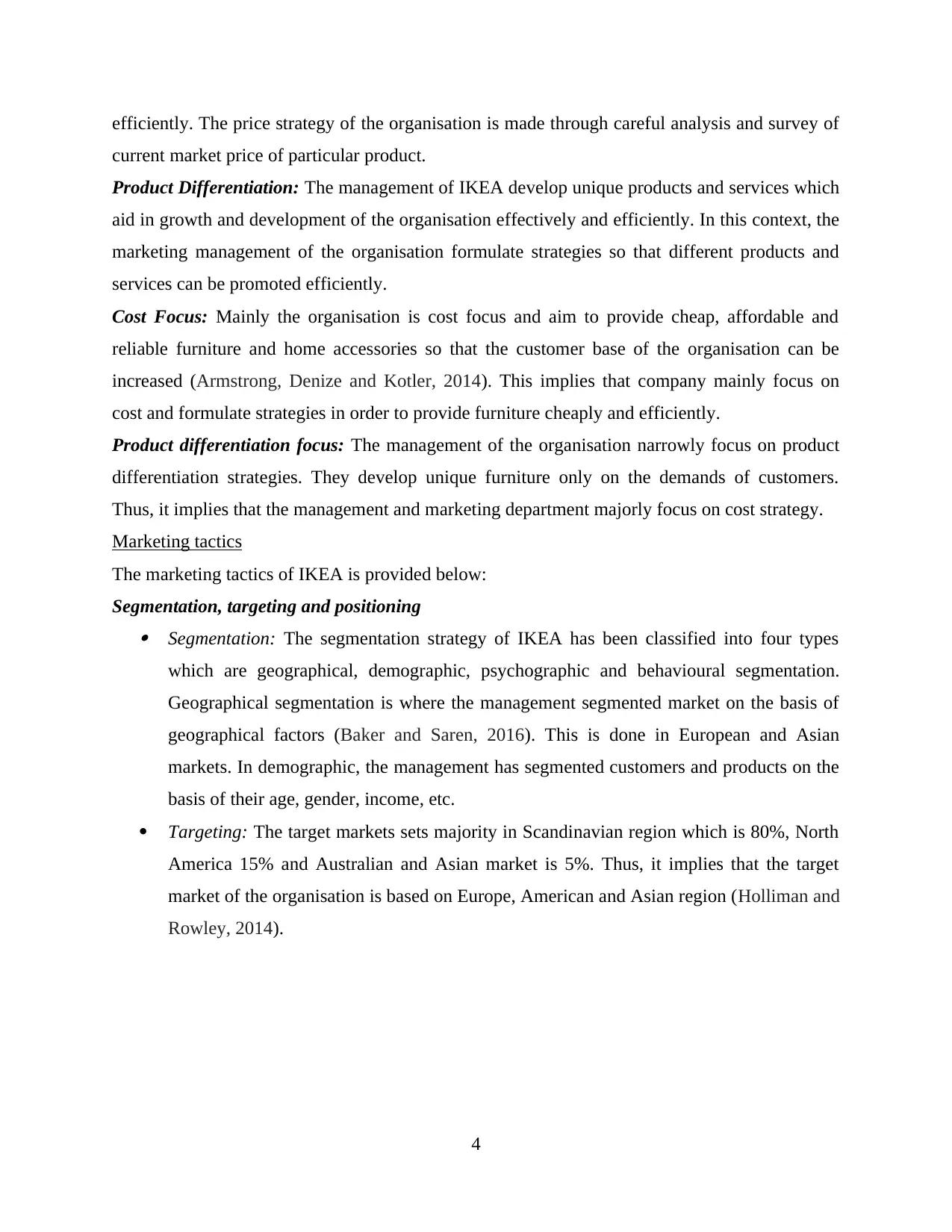
efficiently. The price strategy of the organisation is made through careful analysis and survey of
current market price of particular product.
Product Differentiation: The management of IKEA develop unique products and services which
aid in growth and development of the organisation effectively and efficiently. In this context, the
marketing management of the organisation formulate strategies so that different products and
services can be promoted efficiently.
Cost Focus: Mainly the organisation is cost focus and aim to provide cheap, affordable and
reliable furniture and home accessories so that the customer base of the organisation can be
increased (Armstrong, Denize and Kotler, 2014). This implies that company mainly focus on
cost and formulate strategies in order to provide furniture cheaply and efficiently.
Product differentiation focus: The management of the organisation narrowly focus on product
differentiation strategies. They develop unique furniture only on the demands of customers.
Thus, it implies that the management and marketing department majorly focus on cost strategy.
Marketing tactics
The marketing tactics of IKEA is provided below:
Segmentation, targeting and positioning Segmentation: The segmentation strategy of IKEA has been classified into four types
which are geographical, demographic, psychographic and behavioural segmentation.
Geographical segmentation is where the management segmented market on the basis of
geographical factors (Baker and Saren, 2016). This is done in European and Asian
markets. In demographic, the management has segmented customers and products on the
basis of their age, gender, income, etc.
Targeting: The target markets sets majority in Scandinavian region which is 80%, North
America 15% and Australian and Asian market is 5%. Thus, it implies that the target
market of the organisation is based on Europe, American and Asian region (Holliman and
Rowley, 2014).
4
current market price of particular product.
Product Differentiation: The management of IKEA develop unique products and services which
aid in growth and development of the organisation effectively and efficiently. In this context, the
marketing management of the organisation formulate strategies so that different products and
services can be promoted efficiently.
Cost Focus: Mainly the organisation is cost focus and aim to provide cheap, affordable and
reliable furniture and home accessories so that the customer base of the organisation can be
increased (Armstrong, Denize and Kotler, 2014). This implies that company mainly focus on
cost and formulate strategies in order to provide furniture cheaply and efficiently.
Product differentiation focus: The management of the organisation narrowly focus on product
differentiation strategies. They develop unique furniture only on the demands of customers.
Thus, it implies that the management and marketing department majorly focus on cost strategy.
Marketing tactics
The marketing tactics of IKEA is provided below:
Segmentation, targeting and positioning Segmentation: The segmentation strategy of IKEA has been classified into four types
which are geographical, demographic, psychographic and behavioural segmentation.
Geographical segmentation is where the management segmented market on the basis of
geographical factors (Baker and Saren, 2016). This is done in European and Asian
markets. In demographic, the management has segmented customers and products on the
basis of their age, gender, income, etc.
Targeting: The target markets sets majority in Scandinavian region which is 80%, North
America 15% and Australian and Asian market is 5%. Thus, it implies that the target
market of the organisation is based on Europe, American and Asian region (Holliman and
Rowley, 2014).
4
Paraphrase This Document
Need a fresh take? Get an instant paraphrase of this document with our AI Paraphraser
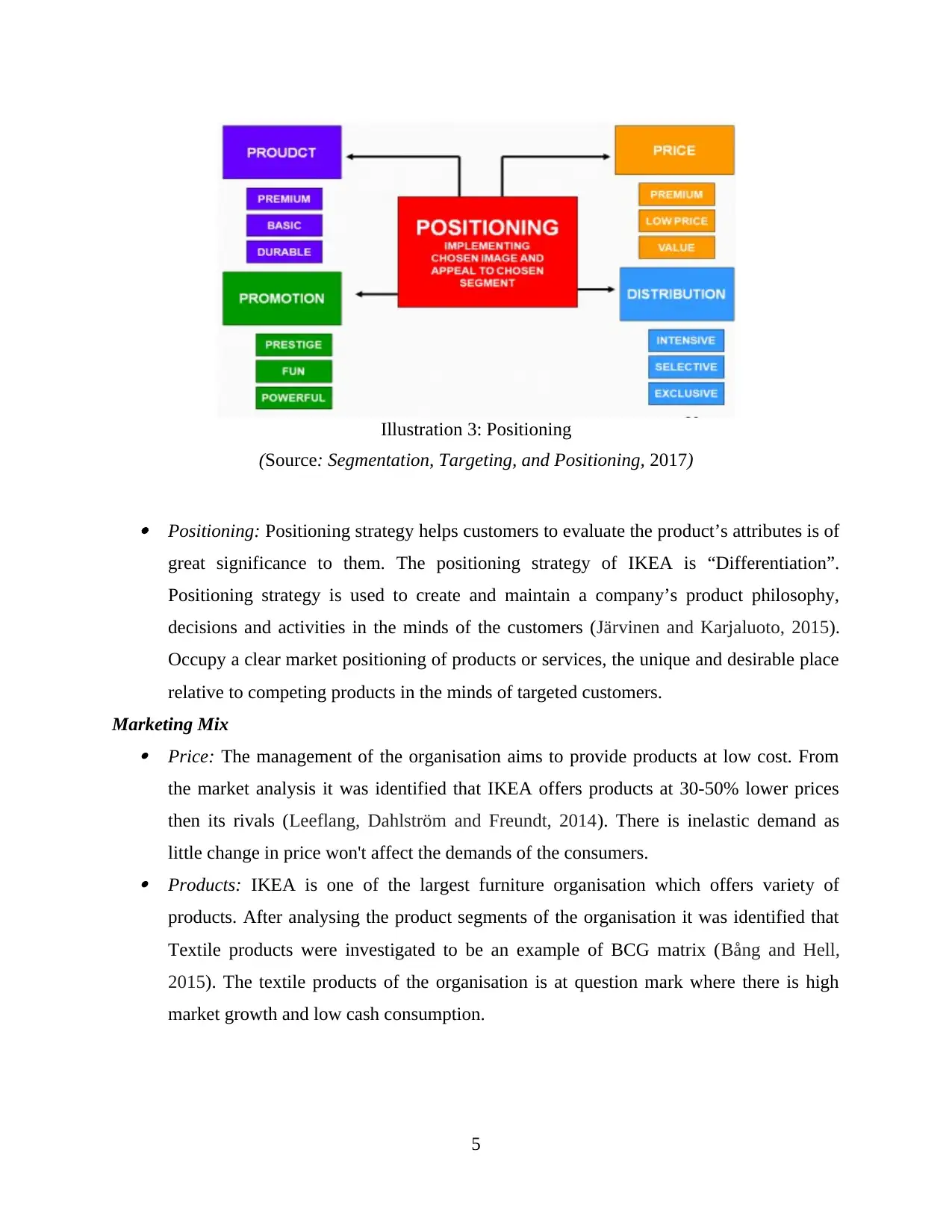
Positioning: Positioning strategy helps customers to evaluate the product’s attributes is of
great significance to them. The positioning strategy of IKEA is “Differentiation”.
Positioning strategy is used to create and maintain a company’s product philosophy,
decisions and activities in the minds of the customers (Järvinen and Karjaluoto, 2015).
Occupy a clear market positioning of products or services, the unique and desirable place
relative to competing products in the minds of targeted customers.
Marketing Mix Price: The management of the organisation aims to provide products at low cost. From
the market analysis it was identified that IKEA offers products at 30-50% lower prices
then its rivals (Leeflang, Dahlström and Freundt, 2014). There is inelastic demand as
little change in price won't affect the demands of the consumers. Products: IKEA is one of the largest furniture organisation which offers variety of
products. After analysing the product segments of the organisation it was identified that
Textile products were investigated to be an example of BCG matrix (Bång and Hell,
2015). The textile products of the organisation is at question mark where there is high
market growth and low cash consumption.
5
Illustration 3: Positioning
(Source: Segmentation, Targeting, and Positioning, 2017)
great significance to them. The positioning strategy of IKEA is “Differentiation”.
Positioning strategy is used to create and maintain a company’s product philosophy,
decisions and activities in the minds of the customers (Järvinen and Karjaluoto, 2015).
Occupy a clear market positioning of products or services, the unique and desirable place
relative to competing products in the minds of targeted customers.
Marketing Mix Price: The management of the organisation aims to provide products at low cost. From
the market analysis it was identified that IKEA offers products at 30-50% lower prices
then its rivals (Leeflang, Dahlström and Freundt, 2014). There is inelastic demand as
little change in price won't affect the demands of the consumers. Products: IKEA is one of the largest furniture organisation which offers variety of
products. After analysing the product segments of the organisation it was identified that
Textile products were investigated to be an example of BCG matrix (Bång and Hell,
2015). The textile products of the organisation is at question mark where there is high
market growth and low cash consumption.
5
Illustration 3: Positioning
(Source: Segmentation, Targeting, and Positioning, 2017)
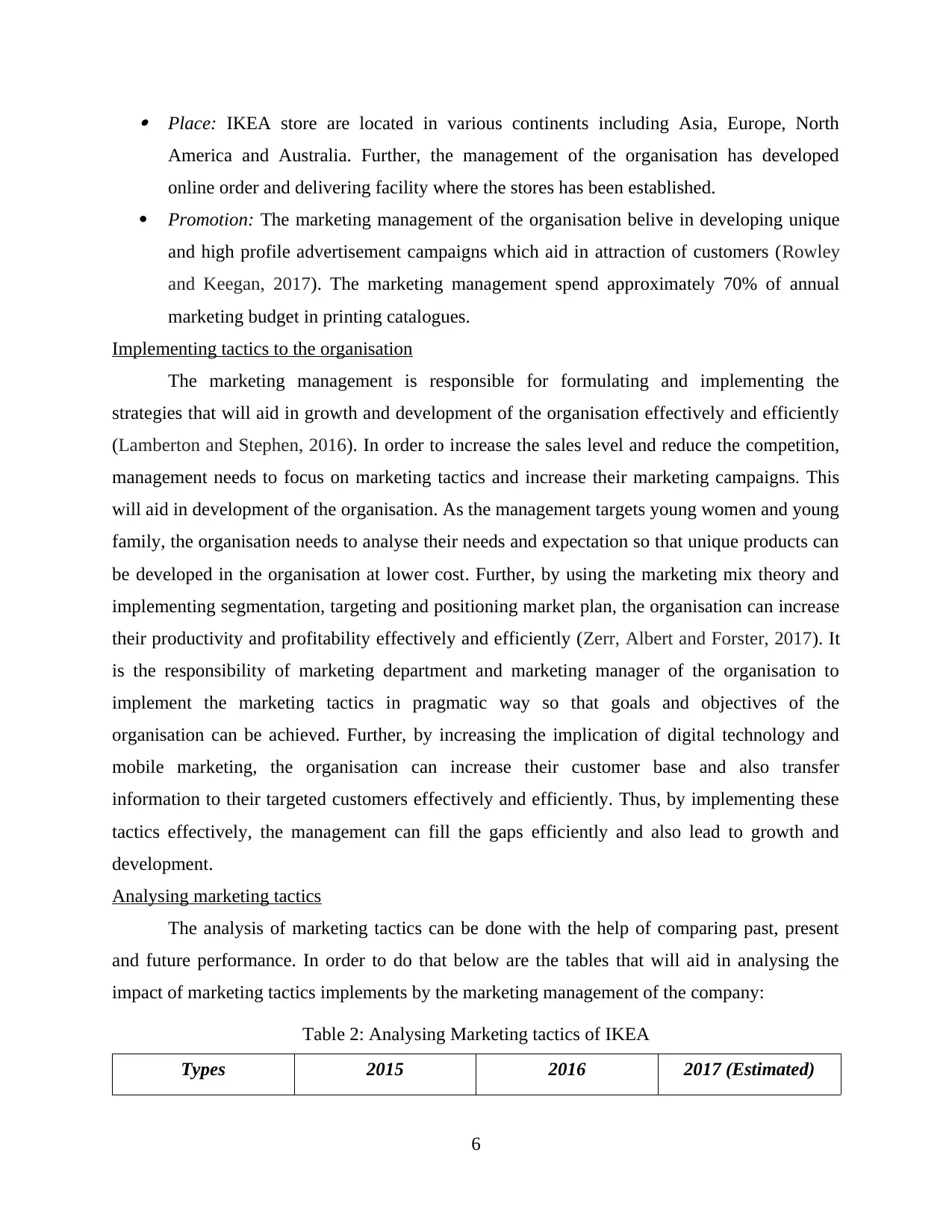
Place: IKEA store are located in various continents including Asia, Europe, North
America and Australia. Further, the management of the organisation has developed
online order and delivering facility where the stores has been established.
Promotion: The marketing management of the organisation belive in developing unique
and high profile advertisement campaigns which aid in attraction of customers (Rowley
and Keegan, 2017). The marketing management spend approximately 70% of annual
marketing budget in printing catalogues.
Implementing tactics to the organisation
The marketing management is responsible for formulating and implementing the
strategies that will aid in growth and development of the organisation effectively and efficiently
(Lamberton and Stephen, 2016). In order to increase the sales level and reduce the competition,
management needs to focus on marketing tactics and increase their marketing campaigns. This
will aid in development of the organisation. As the management targets young women and young
family, the organisation needs to analyse their needs and expectation so that unique products can
be developed in the organisation at lower cost. Further, by using the marketing mix theory and
implementing segmentation, targeting and positioning market plan, the organisation can increase
their productivity and profitability effectively and efficiently (Zerr, Albert and Forster, 2017). It
is the responsibility of marketing department and marketing manager of the organisation to
implement the marketing tactics in pragmatic way so that goals and objectives of the
organisation can be achieved. Further, by increasing the implication of digital technology and
mobile marketing, the organisation can increase their customer base and also transfer
information to their targeted customers effectively and efficiently. Thus, by implementing these
tactics effectively, the management can fill the gaps efficiently and also lead to growth and
development.
Analysing marketing tactics
The analysis of marketing tactics can be done with the help of comparing past, present
and future performance. In order to do that below are the tables that will aid in analysing the
impact of marketing tactics implements by the marketing management of the company:
Table 2: Analysing Marketing tactics of IKEA
Types 2015 2016 2017 (Estimated)
6
America and Australia. Further, the management of the organisation has developed
online order and delivering facility where the stores has been established.
Promotion: The marketing management of the organisation belive in developing unique
and high profile advertisement campaigns which aid in attraction of customers (Rowley
and Keegan, 2017). The marketing management spend approximately 70% of annual
marketing budget in printing catalogues.
Implementing tactics to the organisation
The marketing management is responsible for formulating and implementing the
strategies that will aid in growth and development of the organisation effectively and efficiently
(Lamberton and Stephen, 2016). In order to increase the sales level and reduce the competition,
management needs to focus on marketing tactics and increase their marketing campaigns. This
will aid in development of the organisation. As the management targets young women and young
family, the organisation needs to analyse their needs and expectation so that unique products can
be developed in the organisation at lower cost. Further, by using the marketing mix theory and
implementing segmentation, targeting and positioning market plan, the organisation can increase
their productivity and profitability effectively and efficiently (Zerr, Albert and Forster, 2017). It
is the responsibility of marketing department and marketing manager of the organisation to
implement the marketing tactics in pragmatic way so that goals and objectives of the
organisation can be achieved. Further, by increasing the implication of digital technology and
mobile marketing, the organisation can increase their customer base and also transfer
information to their targeted customers effectively and efficiently. Thus, by implementing these
tactics effectively, the management can fill the gaps efficiently and also lead to growth and
development.
Analysing marketing tactics
The analysis of marketing tactics can be done with the help of comparing past, present
and future performance. In order to do that below are the tables that will aid in analysing the
impact of marketing tactics implements by the marketing management of the company:
Table 2: Analysing Marketing tactics of IKEA
Types 2015 2016 2017 (Estimated)
6
⊘ This is a preview!⊘
Do you want full access?
Subscribe today to unlock all pages.

Trusted by 1+ million students worldwide
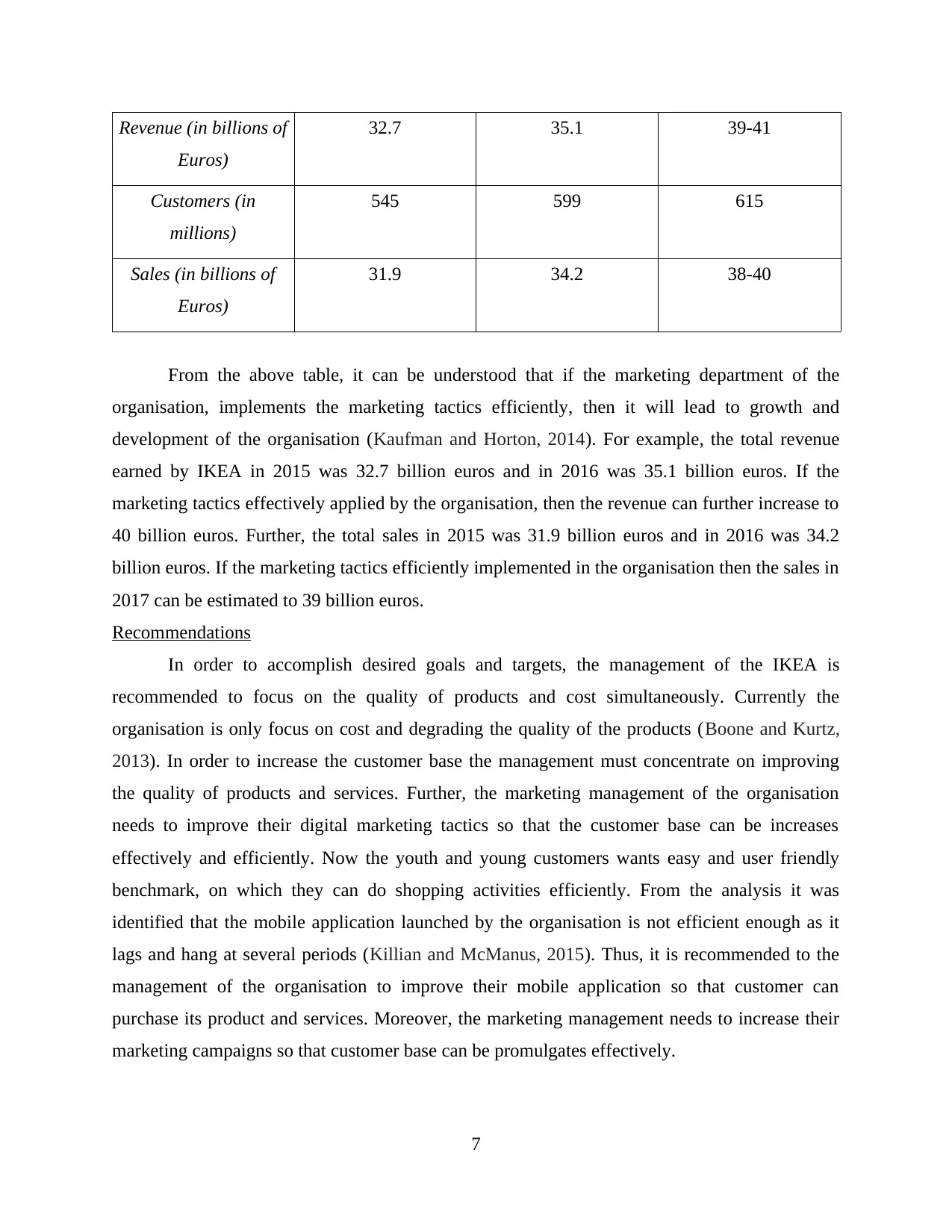
Revenue (in billions of
Euros)
32.7 35.1 39-41
Customers (in
millions)
545 599 615
Sales (in billions of
Euros)
31.9 34.2 38-40
From the above table, it can be understood that if the marketing department of the
organisation, implements the marketing tactics efficiently, then it will lead to growth and
development of the organisation (Kaufman and Horton, 2014). For example, the total revenue
earned by IKEA in 2015 was 32.7 billion euros and in 2016 was 35.1 billion euros. If the
marketing tactics effectively applied by the organisation, then the revenue can further increase to
40 billion euros. Further, the total sales in 2015 was 31.9 billion euros and in 2016 was 34.2
billion euros. If the marketing tactics efficiently implemented in the organisation then the sales in
2017 can be estimated to 39 billion euros.
Recommendations
In order to accomplish desired goals and targets, the management of the IKEA is
recommended to focus on the quality of products and cost simultaneously. Currently the
organisation is only focus on cost and degrading the quality of the products (Boone and Kurtz,
2013). In order to increase the customer base the management must concentrate on improving
the quality of products and services. Further, the marketing management of the organisation
needs to improve their digital marketing tactics so that the customer base can be increases
effectively and efficiently. Now the youth and young customers wants easy and user friendly
benchmark, on which they can do shopping activities efficiently. From the analysis it was
identified that the mobile application launched by the organisation is not efficient enough as it
lags and hang at several periods (Killian and McManus, 2015). Thus, it is recommended to the
management of the organisation to improve their mobile application so that customer can
purchase its product and services. Moreover, the marketing management needs to increase their
marketing campaigns so that customer base can be promulgates effectively.
7
Euros)
32.7 35.1 39-41
Customers (in
millions)
545 599 615
Sales (in billions of
Euros)
31.9 34.2 38-40
From the above table, it can be understood that if the marketing department of the
organisation, implements the marketing tactics efficiently, then it will lead to growth and
development of the organisation (Kaufman and Horton, 2014). For example, the total revenue
earned by IKEA in 2015 was 32.7 billion euros and in 2016 was 35.1 billion euros. If the
marketing tactics effectively applied by the organisation, then the revenue can further increase to
40 billion euros. Further, the total sales in 2015 was 31.9 billion euros and in 2016 was 34.2
billion euros. If the marketing tactics efficiently implemented in the organisation then the sales in
2017 can be estimated to 39 billion euros.
Recommendations
In order to accomplish desired goals and targets, the management of the IKEA is
recommended to focus on the quality of products and cost simultaneously. Currently the
organisation is only focus on cost and degrading the quality of the products (Boone and Kurtz,
2013). In order to increase the customer base the management must concentrate on improving
the quality of products and services. Further, the marketing management of the organisation
needs to improve their digital marketing tactics so that the customer base can be increases
effectively and efficiently. Now the youth and young customers wants easy and user friendly
benchmark, on which they can do shopping activities efficiently. From the analysis it was
identified that the mobile application launched by the organisation is not efficient enough as it
lags and hang at several periods (Killian and McManus, 2015). Thus, it is recommended to the
management of the organisation to improve their mobile application so that customer can
purchase its product and services. Moreover, the marketing management needs to increase their
marketing campaigns so that customer base can be promulgates effectively.
7
Paraphrase This Document
Need a fresh take? Get an instant paraphrase of this document with our AI Paraphraser
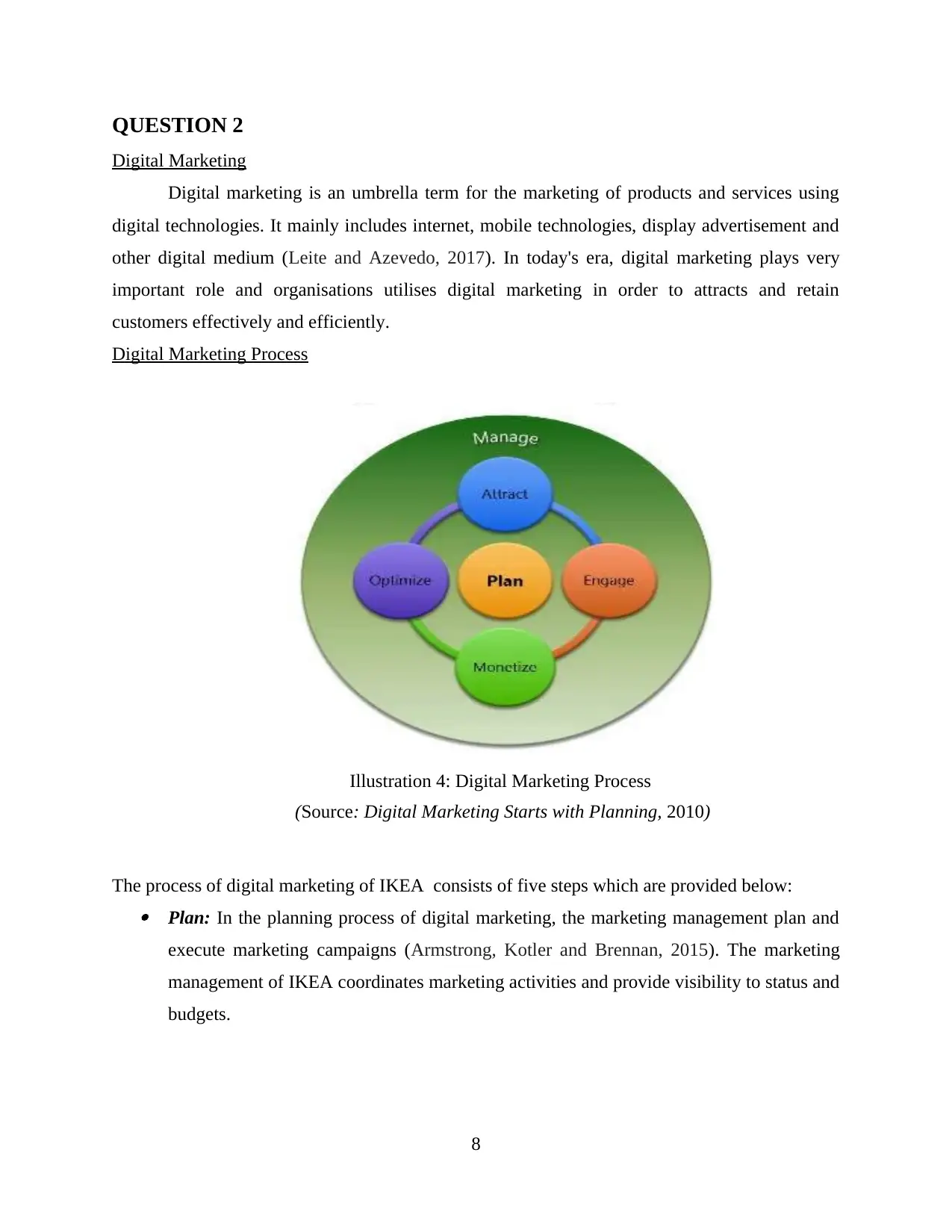
QUESTION 2
Digital Marketing
Digital marketing is an umbrella term for the marketing of products and services using
digital technologies. It mainly includes internet, mobile technologies, display advertisement and
other digital medium (Leite and Azevedo, 2017). In today's era, digital marketing plays very
important role and organisations utilises digital marketing in order to attracts and retain
customers effectively and efficiently.
Digital Marketing Process
The process of digital marketing of IKEA consists of five steps which are provided below: Plan: In the planning process of digital marketing, the marketing management plan and
execute marketing campaigns (Armstrong, Kotler and Brennan, 2015). The marketing
management of IKEA coordinates marketing activities and provide visibility to status and
budgets.
8
Illustration 4: Digital Marketing Process
(Source: Digital Marketing Starts with Planning, 2010)
Digital Marketing
Digital marketing is an umbrella term for the marketing of products and services using
digital technologies. It mainly includes internet, mobile technologies, display advertisement and
other digital medium (Leite and Azevedo, 2017). In today's era, digital marketing plays very
important role and organisations utilises digital marketing in order to attracts and retain
customers effectively and efficiently.
Digital Marketing Process
The process of digital marketing of IKEA consists of five steps which are provided below: Plan: In the planning process of digital marketing, the marketing management plan and
execute marketing campaigns (Armstrong, Kotler and Brennan, 2015). The marketing
management of IKEA coordinates marketing activities and provide visibility to status and
budgets.
8
Illustration 4: Digital Marketing Process
(Source: Digital Marketing Starts with Planning, 2010)
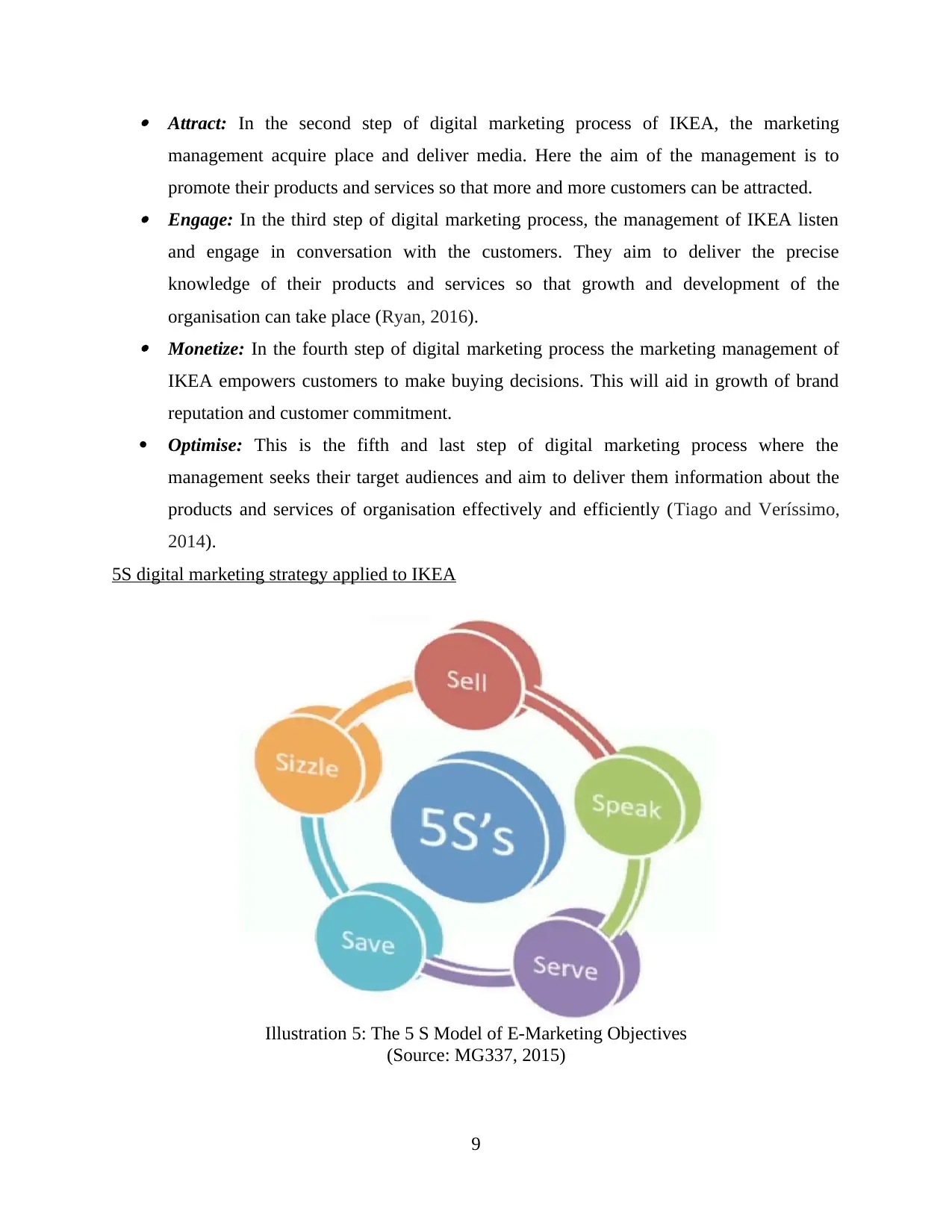
Attract: In the second step of digital marketing process of IKEA, the marketing
management acquire place and deliver media. Here the aim of the management is to
promote their products and services so that more and more customers can be attracted. Engage: In the third step of digital marketing process, the management of IKEA listen
and engage in conversation with the customers. They aim to deliver the precise
knowledge of their products and services so that growth and development of the
organisation can take place (Ryan, 2016). Monetize: In the fourth step of digital marketing process the marketing management of
IKEA empowers customers to make buying decisions. This will aid in growth of brand
reputation and customer commitment.
Optimise: This is the fifth and last step of digital marketing process where the
management seeks their target audiences and aim to deliver them information about the
products and services of organisation effectively and efficiently (Tiago and Veríssimo,
2014).
5S digital marketing strategy applied to IKEA
9
Illustration 5: The 5 S Model of E-Marketing Objectives
(Source: MG337, 2015)
management acquire place and deliver media. Here the aim of the management is to
promote their products and services so that more and more customers can be attracted. Engage: In the third step of digital marketing process, the management of IKEA listen
and engage in conversation with the customers. They aim to deliver the precise
knowledge of their products and services so that growth and development of the
organisation can take place (Ryan, 2016). Monetize: In the fourth step of digital marketing process the marketing management of
IKEA empowers customers to make buying decisions. This will aid in growth of brand
reputation and customer commitment.
Optimise: This is the fifth and last step of digital marketing process where the
management seeks their target audiences and aim to deliver them information about the
products and services of organisation effectively and efficiently (Tiago and Veríssimo,
2014).
5S digital marketing strategy applied to IKEA
9
Illustration 5: The 5 S Model of E-Marketing Objectives
(Source: MG337, 2015)
⊘ This is a preview!⊘
Do you want full access?
Subscribe today to unlock all pages.

Trusted by 1+ million students worldwide
1 out of 19
Related Documents
Your All-in-One AI-Powered Toolkit for Academic Success.
+13062052269
info@desklib.com
Available 24*7 on WhatsApp / Email
![[object Object]](/_next/static/media/star-bottom.7253800d.svg)
Unlock your academic potential
Copyright © 2020–2025 A2Z Services. All Rights Reserved. Developed and managed by ZUCOL.





